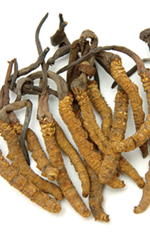
Cordyceps Mushroom (Cordyceps sinensis)
 Cordyceps Mushroom (Cordyceps sinensis)
Cordyceps Mushroom (Cordyceps sinensis)
Stamina, Endurance and Sex Drive
Cordyceps (Cordyceps sinensis) is a special mushroom that can only be found in the mountains more than 12,000 feet above sea level in the southwestern areas of China and Nepal. Cordyceps is regarded as one of the most valuable and expensive herbs in traditional Chinese medicine. They say that, in ancient China, Cordyceps was taken as an elixir of life and only the imperial family could afford it. In 1993, women track athletes from China astonished the world as they broke world records one after another in the World Championships in Athletics in Stuttgart, Germany and the Chinese National Championship in Beijing, China. One of them broke the record for the 10,000 meter-run by an astounding 42 seconds. What was their secret? They gave credit to an intense training schedule and the use of Cordyceps. Since then, Cordyceps has received international attention, and its pharmacological properties have been evaluated in detail. Cordyceps may be useful as an anti-aging aid; lowering high cholesterol, protecting the liver, increasing sex drive, and supporting the heart.
Bioactive constituents:
3′-deoxyadenosine, Cordycepic acid, Steroids, Galactomannan, β-glucan
Bioactivities:
• Cardiotonic: Strengthens driving power of cardiac muscle
• Energy enhancement: Increases erythrocyte / Enhances endurance
• Anti-aging: Prevents the formation of peroxide lipids / Improves memory
• Enhancing sex drive / Anti-impotence: Inhibits phasic and tonic contraction of corpus cavernosum penis
• Hepatoprotection: Reduces the ascites from liver cirrhosis / Prevents the formation of fibroid liver / Normalizes GOT (AST) and GPT (ALT)
• Kidney tonic: Ameliorates aminoglycoside nephrotoxicity
• Anti-tumor: Enhances immune functions
• Anti-diabetes: Increases insulin secretion
• Anti-hypertension: Dilates coronary artery / Increases blood flow
• Stomach tonic: Inhibits the formation of stress-related stomach ulcer
References:
(1) J. Yoshida, Japan J. Exper. Med., 59:157 (1989)
(2) N. Yamaguchi et al, Biotherapy, 2(3):199 (1990)
(3) L. Zhou et al, Materia Medica, 15:53 (1990)
(4) Naoki et al, Abstracts from the Fifth Mycological Congress, 14 (1994)
(5) Y. C. Kuo et al, Cancer Investigation, 12(6):611 (1994)
(6) Z. D. Bao et al, Zhong Guo Zhong Xi Yi Jie He Za Zhi (Chinese), 14(5):271 (1994)
(7) A. Tsunoo et al, Science and Cultivation of Edible Fungi, Balkema, p. 425 (1995)
(8) T. Kiho et al, Food reviews International, 11(1):231 (1995)
(9) N. Manabe et al, Jpa. J. Pharmacol., 70:85 (1996)
(10) T. Kiho et al, Biol Pharmacol. Bull., 16:1291 (1993); 19:294 (1996)
(11) T. Hiyoshi et al, Jpn. J. Physical Fitness and Sports Medicine (Japanese), 45(4):474 (1996)
(12) N. Taketomo, Kagaku to kogyo (Japanese), 51(10):1614 (1998)
(13) N. Kinjo, Tochukaso (Japanese), Health Way, p.1 (1999)
(14) T. Mizuno, International Journal of Medicinal Mushrooms, 1(3):251 (1999)














